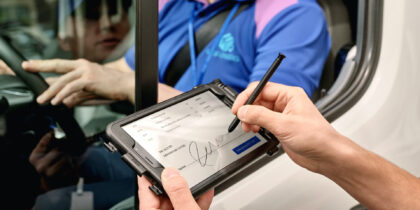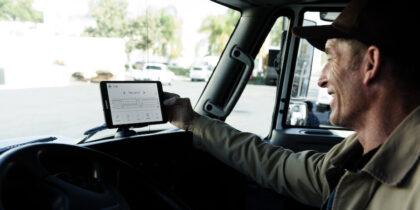For logistics firms without an effective mobility solution, it can be difficult for managers to track the performance of drivers, warehouse workers, couriers and those who work away from direct supervision. Small actions can cascade, wasting thousands of gallons of gas and delaying customer fulfillment, and it can be next to impossible to track the reasons for rising costs or customer dissatisfaction.
Think about the cost of idling trucks. According to Truckinginfo, a typical line-haul fleet spends 20 to 30 percent of its time idling over the course of year, and in some fleets trucks spend up to 40 percent of the time with the engine running but not moving. Given the price of diesel, that can add up to millions of lost dollars. Pedal-to-the-metal starts can hike fuel costs, too. In fact, Levant Power says the difference in fuel usage between a good driver and a bad driver can be 20 percent or more. Add in the cost of time wasted due to bad directions and traffic congestion and suddenly one can see the savings from digitally gauging a fleet’s performance. Even though an over-the-road driver might cover more than 100,000 miles per year, many fleets still use paper to track the activities of a $300,000 asset.
Logistics Mobility Provides Flexibility and Performance
Not too many years ago, the existing logistics mobility solutions were expensive, proprietary in-cab mounted devices. They couldn’t be upgraded and couldn’t leave the truck. But the introduction of ruggedized mobile devices has changed the landscape for on-the-go computing. Today, applications from Samsung partner Telogis Inc. deployed on a Samsung Galaxy Tab® Active tablet deliver flexibility for drivers and fleet managers. Many drivers already use tablets and smartphones in their home lives, so the interface is familiar. There’s much less of a learning curve than with a proprietary system.
Drivers can use tablets for their Electronic Visual Inspection Report (EVIR) and other tasks around the truck. “They can take pictures, use QR codes. They can do all sorts of things to make it a real proactive environment for the driver,” says Erin Cave, vice president of product management, navigation and compliance for Telogis. With fleet applications, managers can track hours of service, driving habits and behavior behind the wheel. Because the Galaxy tablet uses the Android™ platform, companies can add other applications relevant to their business’ or drivers’ needs. For example, fleets can allow drivers to use tablets as entertainment and communication platforms when parked. These are vital for driver retention, helping them stay connected to their families on the road, according to Cave.
Targeted navigation is a powerful tool as well, ensuring efficiency and safety for drivers and cargo by giving real-time updates to approved routes. “You can update the road network on a dynamic system. Say there’s a tornado going through Oklahoma, or Massachusetts is shut down due to a blizzard. We can proactively shut down those roads and drivers will know not to take them,” Cave said. “Those were real situations we were able to react to.”
The system can also route drivers to use the company’s preferred fuel vendors, and geofence capabilities can direct trucks to the correct entry gate and loading dock. “There are all sorts of things you can do that improve safety and deliver tremendous productivity gains with commercial navigation systems along lines of 30 percent,” Cave said. “The more you use those features the better results you’ll get.”
Gamification Encourages Performance Compliance
Mobility solutions have a difficult goal: to change drivers’ behavior. Making a game of it can help. According to eMarketer, mobile gaming is expected to be a $3 billion market in 2015, and with the Telogis Coach application, fleet managers can use the power of gaming to nudge driver behavior in the right direction.
All the data collected on the road feeds into the fleet management system. With it, the telematics managers can track performance indicators such as speed levels, EVIR compliance, route compliance and idling time. In addition to tracking compliance and managing resources, drivers can compete among themselves to stay high in efficiency rankings. A driver may change driving and idling styles to score better in fuel economy rankings and boost their overall score.
“It’s like the fitness monitoring apps. You can mentally motivate yourself because you don’t want to come in second,” Cave said. “It brings a little fun to it for the drivers and gives them something to think about.”
The mobile revolution has transformed logistics mobility solutions, delivering innovative ways to operate fleets more safely and efficiently. These tools give drivers and fleet managers the ability to monitor and manage navigation in real time and track performance statistics for optimal service levels.
Are you ready to streamline your company’s logistics operations and boost your bottom line? Check out Samsung’s line of rugged, powerful tablets to get started.







